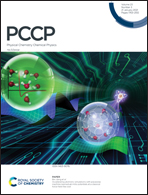The mechanism of the selective binding ability between opiate metabolites and acyclic cucurbit[4]uril: an MD/DFT study†
Abstract
Subtle changes in molecular structure often lead to significant differences in host–guest interactions, which result in different host–guest recognition capabilities and dynamics behaviours in complex formation. Herein, we reveal the influence of the guest substituents on host–guest molecular recognition by molecular dynamics (MD) simulation and density functional theory (DFT) approaches. The results suggest that the binding energy barrier of acyclic cucurbit[4]uril (ACB[4]) with opiate metabolites gradually decreases. The methyl group in morphine (MOR) and morphine-3-glucuronide (M3G) strengthens the hydrophobicity of the guest, while depressing the energy loss of the desolvation of polar groups (e.g. hydroxyl) inside the ACB[4] cavity. However, in M3G, the 3-glucuronide group located outside the ACB[4] host cavity effectively alleviates the unfavourable desolvation effect of the hydroxyl and increases the binding constant by two orders of magnitude (compared with normorphine (NMOR)). Our findings stressed the essentiality of the binding mode and intermolecular noncovalent interactions in the host–guest selective binding ability.
![Graphical abstract: The mechanism of the selective binding ability between opiate metabolites and acyclic cucurbit[4]uril: an MD/DFT study](/en/Image/Get?imageInfo.ImageType=GA&imageInfo.ImageIdentifier.ManuscriptID=D0CP05728B&imageInfo.ImageIdentifier.Year=2021)


 Please wait while we load your content...
Please wait while we load your content...